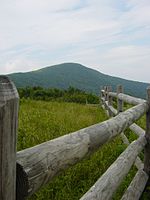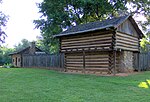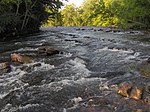Elizabethton Covered Bridge
Bridges completed in 1882Buildings and structures in Carter County, TennesseeCovered bridges on the National Register of Historic Places in TennesseeElizabethton, TennesseeFestivals in Tennessee ... and 11 more
Historic American Buildings Survey in TennesseeHistoric American Engineering Record in TennesseeHistoric district contributing properties in TennesseeHowe truss bridges in the United StatesNRHP infobox with nocatNational Register of Historic Places in Carter County, TennesseeRoad bridges on the National Register of Historic Places in TennesseeTourist attractions in Carter County, TennesseeTransportation in Carter County, TennesseeUse mdy dates from August 2023Wooden bridges in Tennessee

The Elizabethton Covered Bridge is a 134-foot (41 m) covered bridge over the Doe River in Elizabethton, the county seat of Carter County, Tennessee. The Elizabethton Covered Bridge was constructed in 1882 and connects 3rd Street and Hattie Avenue.
Excerpt from the Wikipedia article Elizabethton Covered Bridge (License: CC BY-SA 3.0, Authors, Images).Elizabethton Covered Bridge
3rd Street,
Geographical coordinates (GPS) Address External links Nearby Places Show on map
Geographical coordinates (GPS)
| Latitude | Longitude |
|---|---|
| N 36.3473 ° | E -82.2118 ° |
Address
Elizabethton Covered Bridge
3rd Street
37643
Tennessee, United States
Open on Google Maps





